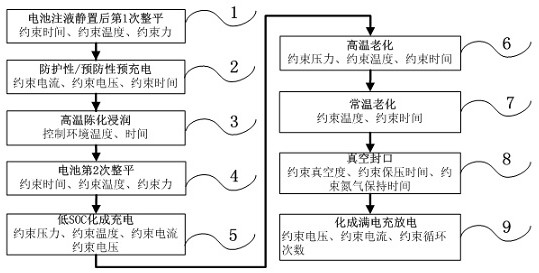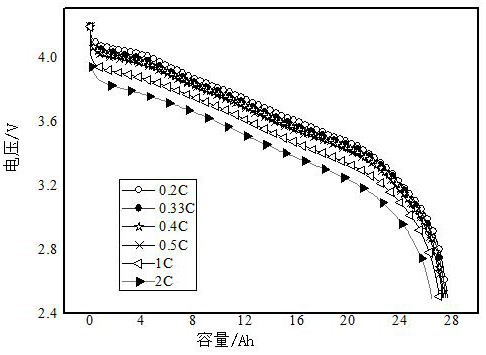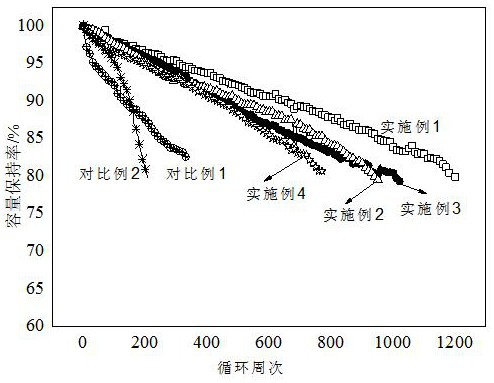A high specific power battery formation process
A power battery and process technology, applied in the field of high-performance power battery formation technology, can solve problems such as affecting electrochemical performance, affecting the formation of SEI film on the surface of the negative electrode, and forming voltage affecting the SEI film of the battery, etc., to achieve improved electrical performance and tight spacing. consistent effect
- Summary
- Abstract
- Description
- Claims
- Application Information
AI Technical Summary
Problems solved by technology
Method used
Image
Examples
Embodiment 1
[0031] The above high-specific characteristic battery is formulated, and the specific steps are as follows:
[0032] 1): The first time the battery is retained. The battery is binding, the temperature of the constraint temperature is flat, and the binding force is 1.6MPa / cm. 2 First constrain high temperature 75 ° C, 1.5 h, after constraints at room temperature 20 ° C, 0.5 h, total time 2H;
[0033] 2): Protective / preventive precharge. Precharge with small magnification 0.01c at room temperature 25 ° C, binding force 1.4MPa / cm 2 ; Constrained charging time is not more than 100 min, constraint voltage 3.3V;
[0034] 3): High temperature aging infiltrated. The control ambient temperature is 45 ° C, time 12h; the airbag is folded 50 ° tilted up, the cell is tiled, and the interval 6h is flipped to ensure the adequate infiltration uniform.
[0035] 4): The battery is the second time. Battery uses binding, constrained temperatures, high temperatures, binding force 1.1MPa / cm 2 ;...
Embodiment 2
[0042] 1): The first time the battery is retained. The battery is binding, the warming of the constraint temperature is flat, and the binding force is 0.7MPa / cm. 2 First constrain high temperature 75 ° C, 1.5 h, after constraints at room temperature 20 ° C, 0.5 h, total time 2H;
[0043] 2): Protective / preventive precharge. Precharge at 25 ° C ± 5 ° C in small magnification, 2 ° C ± 5 ° C, binding force 1.4MPa / cm 2 ; Constrained charging time is not more than 100 min, constraint voltage 3.3V;
[0044] 3): High temperature aging infiltrated. The control ambient temperature is 45 ° C, time 12h; the airbag is folded 50 ° tilted up, the cell is tiled, and the interval 6h is flipped to ensure the adequate infiltration uniform.
[0045] 4): The battery is the second time. Battery uses binding, constrained temperatures, high temperatures, binding force 1.1MPa / cm 2 ; Constraint time 2 h, constraint temperature is 65 ° C;
[0046] 5): Low SOC is chemically charged. The constraint t...
Embodiment 3
[0052] 1): The first time the battery is retained. The battery is binding, the temperature of the constraint temperature is flat, and the binding force is 1.0MPa / cm. 2 First constrain high temperature of 60 ° C, 1.0 h, after constraint at room temperature 30 ° C, 0.5H, total time 1.5H;
[0053] 2): Protective / preventive precharge. Precharge at 25 ° C ± 5 ° C in small magnification, ± 5 ° C, binding force 0.6MPa / cm 2 ; Constrained charging time is not more than 100 min, constraint voltage 3.3V;
[0054] 3): High temperature aging infiltrated. The control ambient temperature is 50 ° C, time 20 h; the airbag is folded 50 ° tilted up, the cell is tiled, and the interval 6h is flipped to ensure the adequate infiltration uniform.
[0055] 4): The battery is the second time. Battery uses binding, constrained temperatures, high temperature, binding force 0.8MPa / cm 2 ; Constraint time 3h, constraint temperature 45 ° C;
[0056] 5): Low SOC is chemically charged. The constraint temp...
PUM
 Login to View More
Login to View More Abstract
Description
Claims
Application Information
 Login to View More
Login to View More - R&D
- Intellectual Property
- Life Sciences
- Materials
- Tech Scout
- Unparalleled Data Quality
- Higher Quality Content
- 60% Fewer Hallucinations
Browse by: Latest US Patents, China's latest patents, Technical Efficacy Thesaurus, Application Domain, Technology Topic, Popular Technical Reports.
© 2025 PatSnap. All rights reserved.Legal|Privacy policy|Modern Slavery Act Transparency Statement|Sitemap|About US| Contact US: help@patsnap.com



